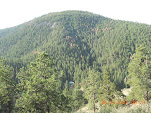Oh, the first shots were awful. Big, bright, cackling roosters coming off point or flush from the old Lab or young Shorthair. Misses, not shooting.....it looked like a long day.
At 5:30am, the neighbors (Shane and Keston) picked us up and we started the day with a drive north, to Cheyenne and then just beyond towards Torrington. A beautiful morning unfolded, and with it the great conversation that comes on car rides with dogs and boys and the looming hunt.
We knew this may very well be Libby's last trip north to hunt. The end of many good seasons. The 12 year old Lab was struggling through shoulder pain, but still showed enough puppy with the puppy to give it one more chance. Bess, the year old German Shorthair that the Downing's got last summer had just returned from a trip to North Dakota to hunt and proved she'd learned a lot. Our first walk produced a stellar point from the young dog (boys shot and missed) and then a flush from the old dog (boys were to surprised to shoot). Ah, moments when you wish it were your hunt.
A few more birds flushed - some missed shots (I think I am remembering this right), and then, finally. The old dog wouldn't quit hunting as we tried to decide what to do. Her swirling tail telling us a flush was imminent. Kabe moved into position and then the flush and then the shot and then the tumble of bird heading back to Earth. Ecstasy. Elation. Relief. The rest of the day would be bonus for the perfect moment of old dog and new hunter. Mile-wide smile. At least two of them.
The walk, back towards the car, was full of excitement. Keston downed a bird. Others flushed wild. At the end of the block of grass we were walking Bess went on point, again. This time betraying the bird. Makabe shot and two roosters were in the game bag. Christmas dinner was secured.
The day got hot, the old dog proved wily in flushing birds the young dog missed. They both hunted their hearts out. We chased flushed birds, the boys got hot. There was an incident with dog and feces. And finally, one last walk.
We headed towards a short block of trees that had held birds in the past. The luck of the hunt had Kabe walking to the southern edge of the trees, Keston went north. Bess, betraying owner, hunted our side, pointed then ran after the running bird, pinned it and flushed the bird back towards us. One more shot (it seemed to take forever for Kabe to pull the trigger - my mind yelling "Shoot!") One more rooster. A limit.
The drive home was swell as well. The boys tired, but not sleeping. A gas stop and junk food feast. And then, at home, the celebration of sisters and mother. The floating of feathers, the encouragement of the little Lab, Juniper, smelling her first pheasant. Three beautiful birds and the swelling pride, confidence and respect of a growing hunter in his first season.




